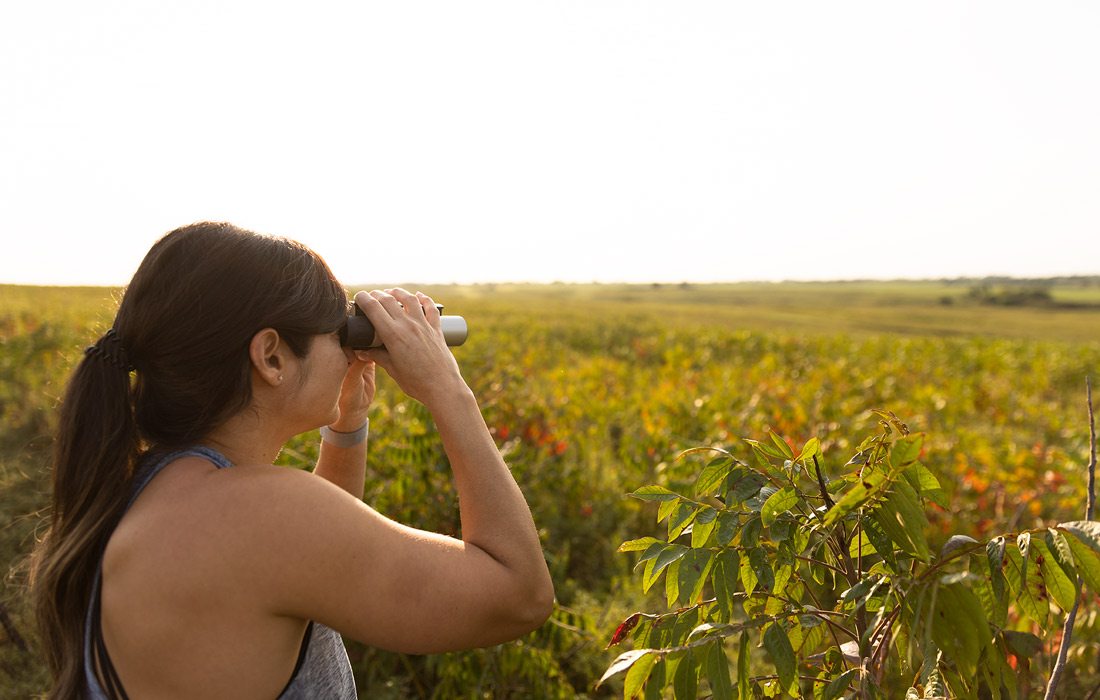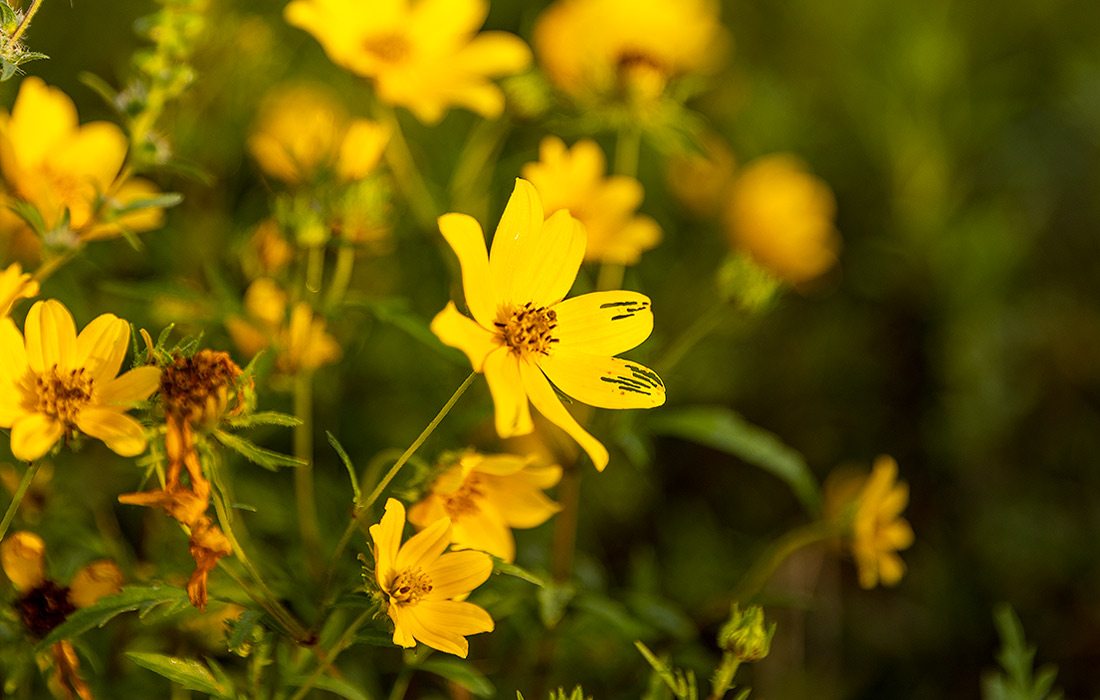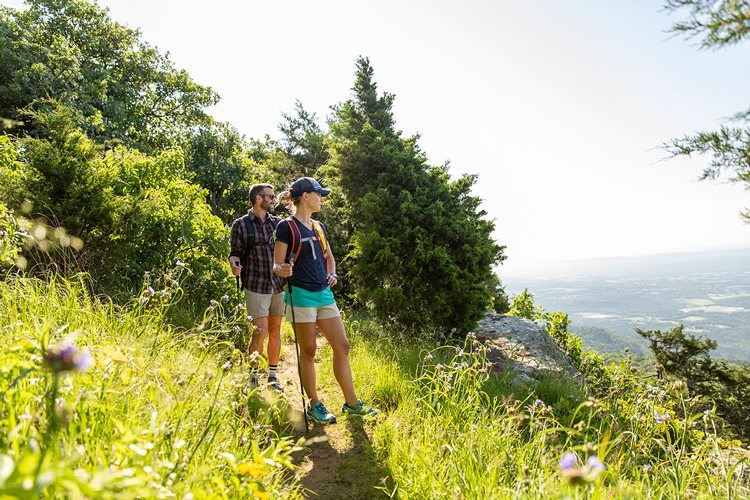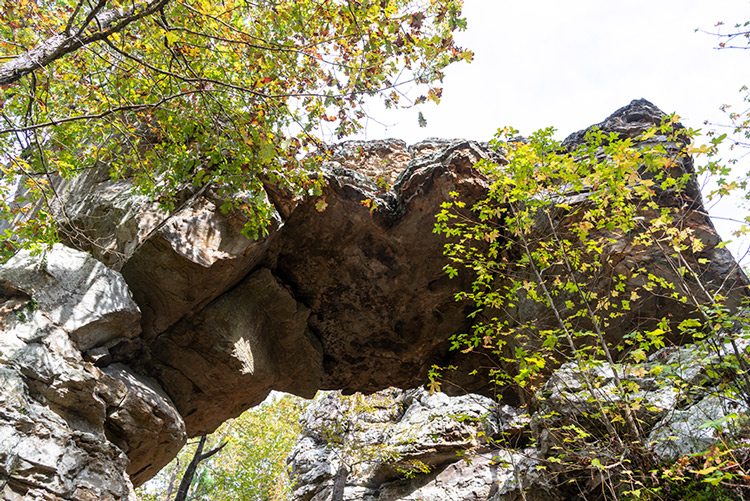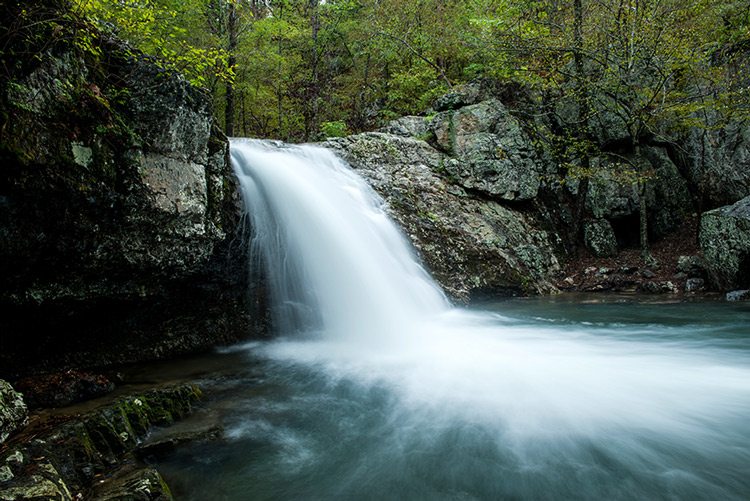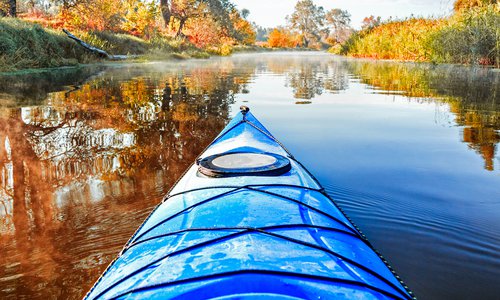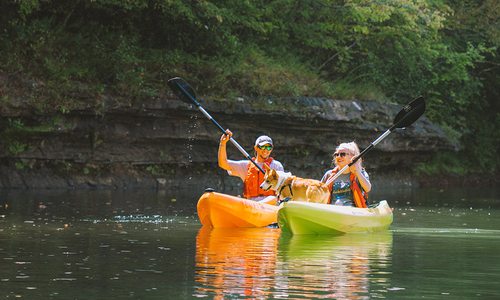Take a sight-seeing trip to Prairie State Park.
Purchase PhotoLifestyle
Our Favorite State Parks
Here's a list of our favorite state parks in southwest Missouri and Arkansas to help you map out your next outdoor adventure.
By Brandon Alms, Katie Pollock Estes, Sony Hocklander, Megan Johnson
Apr 2025

Natural wonders, towering bluffs, peaceful forests and sprawling prairies stretch across the Ozarks and nearby parts of Missouri—and those scenic state park landscapes are just waiting for you to explore them. Pack up the family or your favorite friends, and plan a trip to the park that speaks to you. We rounded up 13 of our favorites (plus five bonus parks in Arkansas) to get you started.
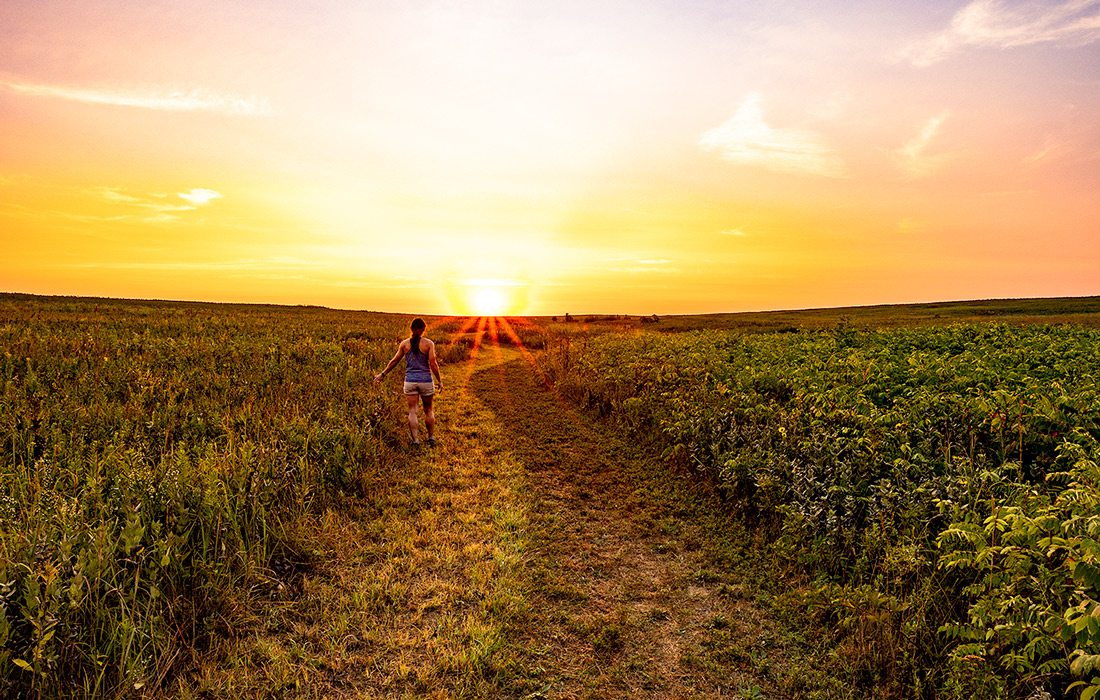
Prairie State Park
128 Northwest 150th Lane, Mindenmines | 1.75 hours west of Springfield
Prairie State Park wins points in our books because of how vastly different it looks from other state parks. It’s Missouri’s largest tallgrass prairie landscape, and with its flat and sprawling lands populated by swaying grass, prairie birds, colorful wildflowers and herds of bison, it looks like another world. And it features seven trails that let you explore it all.
After receiving the assignment to photograph Prairie State Park, I set out to achieve two main goals. One was to experience and capture the vast open prairie fields at sunrise, and the other was to find and photograph the bison herd. My wife, Martha, and I arrived at the park right before sunrise in just enough time to capture the burst of sunrays peeking along the horizon line. The sky filled with saturated oranges, pinks and purples. Goal number 1, check!
Not knowing where to start the process of tracking the bison herd, we circled back around to the Tallgrass Prairie Nature Center. Although it wasn’t open yet, we were able to pick up some printed trail maps that were available outside the front entrance. This was very helpful, as the trails right by the visitors center aren’t really marked. They are simply plowed paths that flow throughout the prairie. We decided to try the much larger loop trail that starts right beside the visitors center next. After unsuccessfully trying to spot the bison for an hour or so, we made our way to the highest point we could find along that trail. Not seeing anything, we broke out a pair of binoculars and there they were! The bison were tiny dark specs several miles away, but it was for sure them.
The problem was that there was no direct trail to the bison. It was time to go off the beaten path. Sounds easy enough as it is a prairie after all, but the prairie is massive with chin-high grasses, wildflowers and slight changes in elevation that made it hard to see. Finally, after a 1.5-hour hike, we were getting close. I attached my telephoto lens, and in a blink of an eye, the entire herd was gone. Before I could fire off a single shot, these massive animals saw us from probably 100 yards out and took off. They made their way all the way back to where we had started a few miles away in what seemed like a matter of seconds. It was truly impressive. Even though I was disappointed that I wasn’t able to get the shots I had pictured in my mind, getting to see the herd move like that in a natural environment was well worth it. I was able to capture a few stragglers of the herd along the trek back, which was the perfect way to end our day.—Brandon Alms, with additional reporting by Katie Pollock Estes
Where to Stay When You Visit Prairie State Park
You can camp at Prairie State Park, but there are no cabins or lodge rooms. We recommend making this a day trip if you’re not a camper.
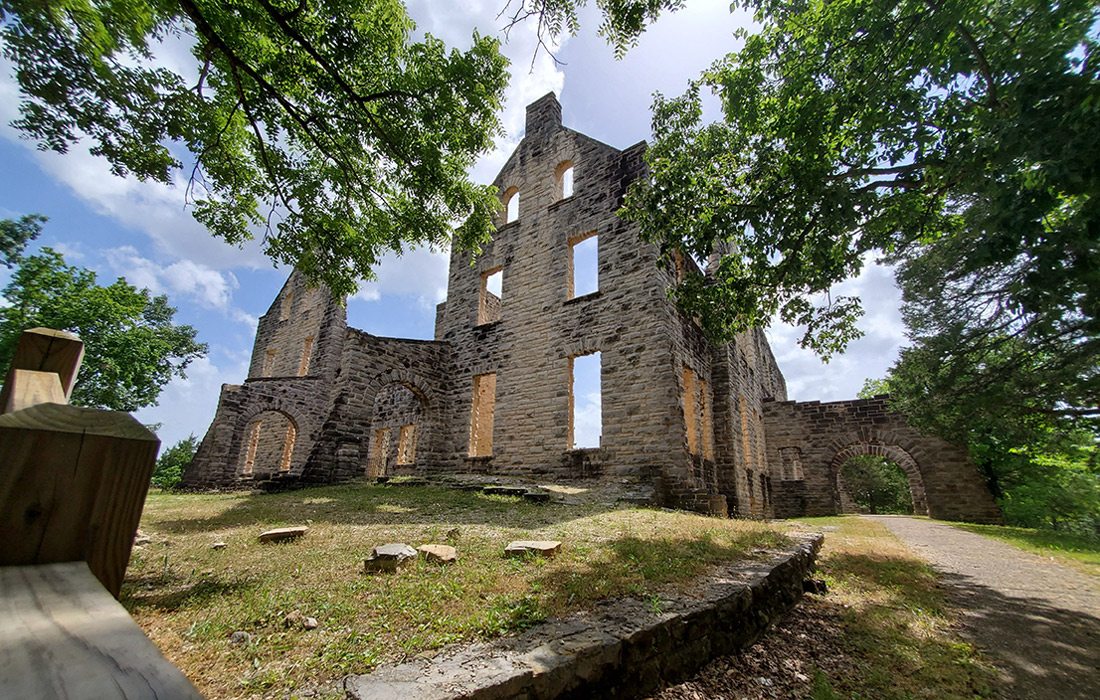
Ha Ha Tonka State Park
1491 State Road D, Camdenton | 1.25 hours northeast of Springfield
Variety is one of the things we love at Ha Ha Tonka, where you can have a different experience every time you visit thanks to the park’s combination of interesting 20th-century castle ruins, a natural bridge and incredible views—and its whopping 14 trails that range from super-easy to heart-pumping. One is even a water trail for boating the Big Niangua River.
When my family visited the park, we made a giant loop, hitting several of those trails. Once we got off the boardwalk sections near the ruins, my kids (6 and 8 at the time) hiked more than 10,000 steps and never complained once. They were constantly entertained by natural pathways, organic terrain and stones to hop around on.
One of the paths we explored was Spring Trail, a 1.4-mile trek that starts off easy then gets steep. When we started our trek up the section of Spring Trail that has 316 wood stairs, we were all weary. But a group of three nuns was about halfway in front of us, and they kept us motivated—if they could finish this wearing their full habits, we knew we could push through. We definitely had to take a few breathers along the way and had a good laugh with the ladies when we all finally made it to the top.
For visitors who come to the park by boat via Lake of the Ozarks, there’s a boat dock that connects to Lake Trail for a 0.4-mile trek up past greenhouse ruins and on toward the castle ruins. As for those ruins… They sit on a hillside that overlooks the lake, and they once belonged to Kansas City businessman Robert M. Snyder, who purchased the land and built a retreat for his family in 1903. In 1942, after the construction of Bagnell Dam and the creation of Lake of the Ozarks, a fire devastated the property. The park was created to preserve the area in 1976, and now visitors can explore the surrounding wilderness, view the ruins and take in the incredible lake and spring vistas.—Megan Johnson, with additional reporting by Katie Pollock Estes
Where to Stay When You Visit Ha Ha Tonka State Park
There are no campsites or cabins here, so we recommend picking an Airbnb on the same side of the lake as Ha Ha Tonka. You can find some in Camdenton that are right on the water, sometimes with swimming platforms and dock.
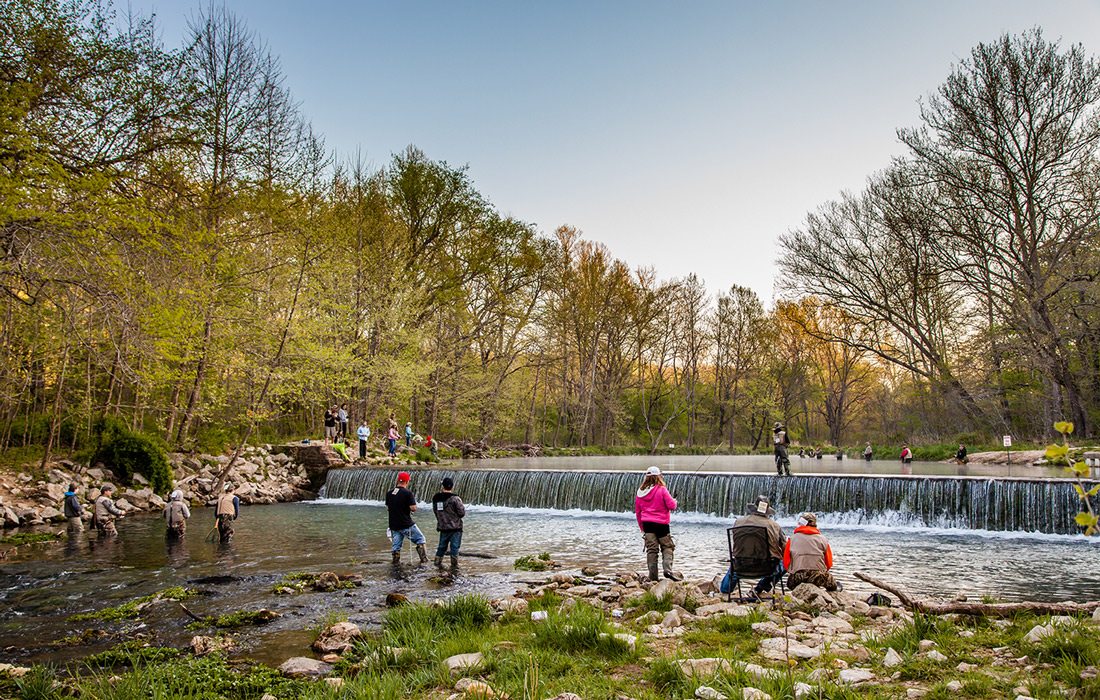
Montauk State Park
345 County Rd. 6670, Salem | 2.25 hours east of Springfield
When we drive down the hill before entering Montauk State Park, the feeling is the same every year: We’re home. There’s something special about this park built around the Current River.
Like Bennett Spring and Roaring River, Montauk is a hatchery-stocked trout park, luring many anglers and their families. The river winds throughout the park from the moment you enter all the way back to the four campgrounds – so there’s plenty of space to fish! Some areas are best for fishing in waders; others are great for bank fishing. And it’s an easy place to teach kids how to land their first trout.
But trust me, fishing is not the only reason to go. For one thing, the park makes a great basecamp for float trips. We generally paddle two different days: Cedar Grove to Akers Ferry is our traditional paddle (with a stop at Welch Spring) and we’ll add a second day float on another stretch.
In our 20-plus years of visiting, we’ve stayed in campgrounds, the lodge motel rooms and in cabins—many of which recently had firepits added. The accommodations aren’t fancy, but they are comfortable. The quaint lodge has a small store with fishing gear, souvenirs and T-shirts, and basic food and convenience store staples. It also has an old-fashioned soda bar (we love getting malts!) and a restaurant.
I’ve walked or cycled practically every inch of the park. There are numerous paths, lots of shade trees mixed with wide grassy areas, several trails, playgrounds in the main park and in campgrounds, shelters for group gatherings and two accessible fishing areas. We find there’s a broad mix of families and fishing friend groups. One of my favorite spots is up by the old hatchery area and spring-generated pools. It’s a peaceful, pretty place to stroll and explore.
The park has other points of interest. Up one road, you can visit a shallow turquoise spring that feels like the birthplace of the Current River, although it’s actually one of several springs that combine with Pigeon Creek to become the Current. And the historic Montauk Mill is a centerpiece as you drive toward the lodge. It’s open to the public at various times when a park ranger shares the mill’s history. Kids always enjoy visiting the hatchery, next to the mill, where rows and rows of pools are teeming with growing trout.
If you haven’t visited Montauk State Park, put it on your list of day trips or make it your next family campout. But book early: Park lodging fills up very fast.—Sony Hocklander
Where to Stay When You Visit Montauk State Park
Montauk State Park has a wide array of rental cabins, lodge motel rooms and four campground sections within the park, along with a lodge store, old-fashioned soda bar and full restaurant. Area accommodations include private campgrounds, cabin rentals or hotels in Salem.
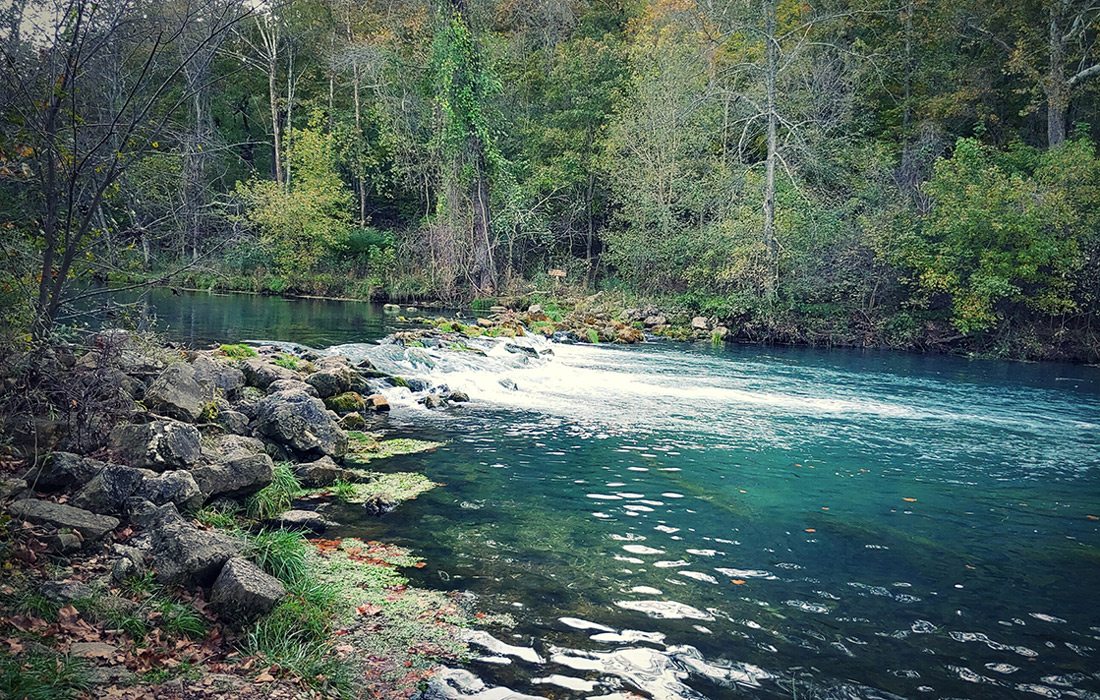
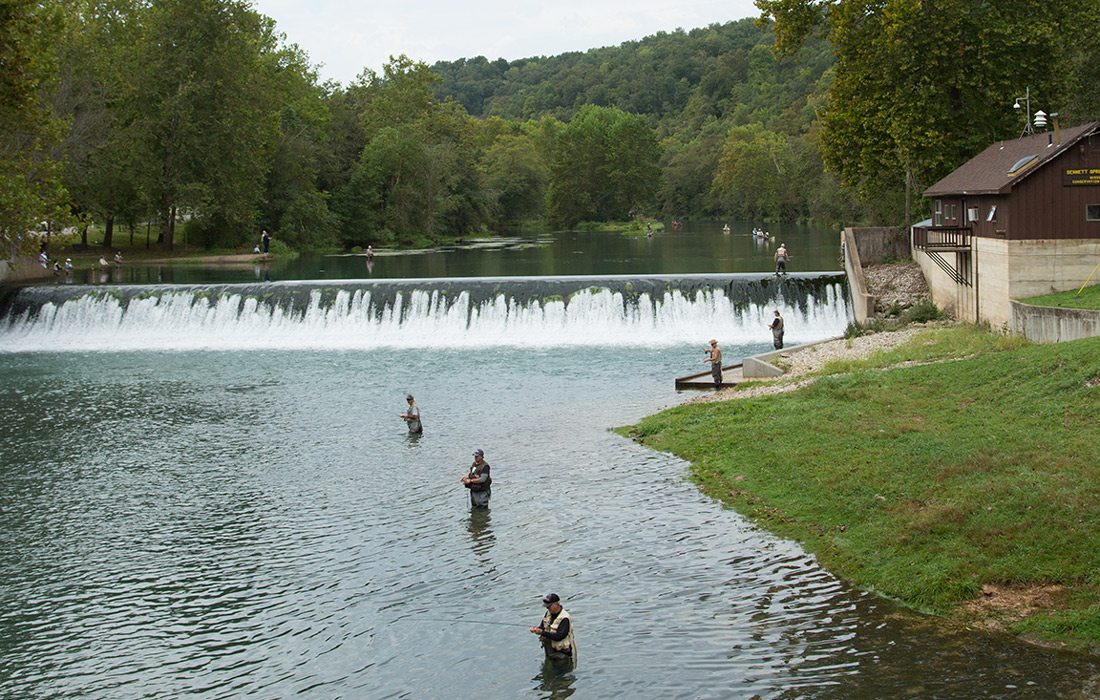
Bennett Spring State Park is synonymous with fishing for local anglers.
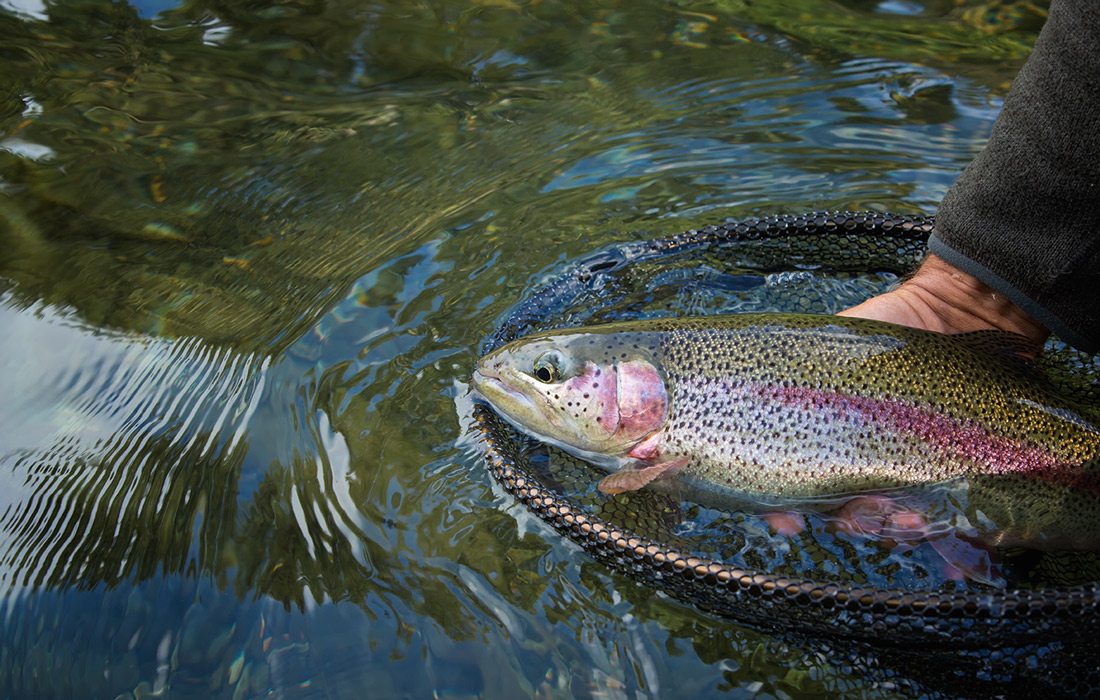
Bennett Spring is one Missouri’s three trout parks within two hours of Springfield.
Bennett Spring State Park
26250 MO-64A, Lebanon | 1.25 hours northeast of Springfield
For local anglers, Bennett Spring State Park is synonymous with fishing. And why not? It’s one of Missouri’s three trout parks within two hours of Springfield. Not only that, it’s in a beautiful valley with historic rock structures including an oft-photographed arched bridge and the rustic dining lodge. Whether you like to fish or not, the nearly 100-year-old park is perfect for hiking, picnics, dining, camping or staying in a cabin or lodge room. Plus, it’s got great dining at the lodge, including buffet-style on the weekends. And if you forgot something at home, try the lodge store.
But first, let’s talk trout! If you’re not familiar with trout parks, the spring-fed stream is stocked with hatchery-raised trout and a daily trout tag is required to cast your line (in addition to a fishing license). Anglers are hooked on trying their luck at a favorite spot, from the spring to the spillway and beyond. We generally fish along branch waters near the spring, a photogenic area that’s close to one small group of cabins and trailheads.
The spring forms a gorgeous sea-green pool — usually lined with anglers in waders —where more than 100 million gallons of water flow into the spring. Casting a cool reflection near the spring is the tower-like stone Gauge House, built in 1935 to predict flooding.
While my spouse would happily fish all day, I prefer hiking Bennett Spring trails. This park has some pretty cool trails. We’ve done a nice 2.5-mile Savannah Ridge Trail loop (it’s not long but is a bit hilly). Expect to spend more time hiking the popular 7.5-mile Tunnel Trail. As the name implies, its centerpiece destination is the nearly 300-foot-long curving natural tunnel (consider bringing a small flashlight!). You can do the loop or hike up and back the same way. The last time I did this trail with friends, creek beds were dry. But in rainy seasons, expect several wet crossings.
To hike something short, family-friendly and educational, try the Oak-Hickory Trail. Make it a self-guided tour via the trail’s interpretive signage about forest life. The nearby Nature Center makes a nice stop too. And kids always love visiting the hatchery.
Another reason to visit? Float the Niangua! Stay in Bennett Spring lodging or campgrounds and book a float with an area outfitter. The river is pretty wide, slow and easy for beginners or families—with one caveat: Don’t go on a summer Saturday unless you are in the mood for a Mardi Gras vibe.
Whether you fish, float, hike or just need a good day outdoors, it’s hard to beat the well-rounded Bennett Spring.—Sony Hocklander
Where to Stay When You Visit Bennett Spring State Park
Bennett Spring State Park offers campsites, rental cabins and motel lodge rooms within the park and there are multiple camping and cabin resorts.
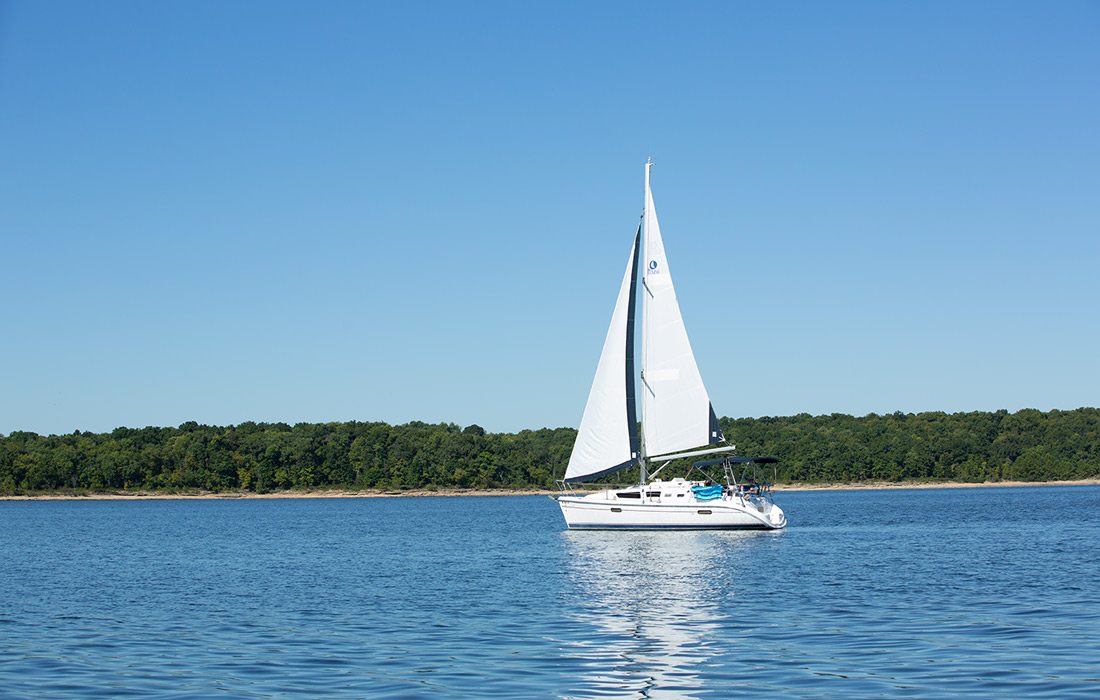
Stockton State Park
19100 MO-215, Dadeville | 1 hour northwest of Springfield
Stockton State Park is a gem in plain sight and a premier sailboat lake. One reason for that is its consistent southwest breeze. In fact, Stockton is considered one of the top 10 sailing lakes nationwide, according to the American Sailing Association. The ASA offers sailing classes through Lake Stockton Boat Works, located near Orlean’s Trail Marina, one of three marinas on the nearly 25,000-acre lake.
Not a sailor? You can still enjoy the sport by attending the Lake Stockton Yacht Club’s 49th Annual Governor’s Cup Regatta Sept. 22–24—the largest in Missouri according to the club. The sight of all those wind-filled sails cutting across the water is breathtaking.
Stockton Lake is also a nice place to paddle a kayak or canoe. Rent vessels and motorboats at any of three marinas: Orlean’s Trail (which also has campgrounds and a resort), Mutton Creek Marina and Campgrounds, and the Stockton State Park Marina, which has lodging rentals, a store and a small café.
If you have your own boat, the Hartley Cove boat ramp and State Park Marina are two places to launch. They are also trailheads for the park’s water trail along 6.65 miles of shoreline that includes limestone bluffs and opportunities to see birds and other wildlife. With only a mile by land between the two launch spots, you can ride a bike from one to the other.
We don’t mountain bike but enjoy seeing cyclists pump their pedals as we step out of the way along a dual-purpose trail like the 1.6-mile Umber Ridge. Enjoy several views of the lake along this trail, and in the spring, look for wildflowers, including trillium, wild hyacinth and more. The Lakeview Trail has nice vista views of the lake, and cyclists seem to enjoy a newer multi-use trail system in the more remote southwest area of the park. The 3.3-mile Sortor’s Bluff Trail goes along Sortor’s Bluff and follows a peninsula near the Sac River. This trail is great for hiking too.
Given its proximity to Springfield, Stockton is a good place to start your kids out camping. (My family camped here.) There are campgrounds available through the park system and through private entities. My brother and family love renting rustic camping cabins, with electricity but no plumbing. (It’s almost like tent camping, only more comfortable.) When it’s hot during summer months, your kids can splash at a swimming beach on the park’s north end.
Don’t forget fishing! The lake attracts anglers who take advantage of its many protected coves (which helps get them out of the wind!). In fact, some bass fishing clubs regularly hold small tournaments. Hooking a bass at Stockton is a favorite but the lake also has crappie, walleye and bluegill.
Nearly anything you enjoy doing outdoors, you’ll find at Stockton State Park. And the best part is, you can go for the day and get home in time for dinner!—Sony Hocklander
Where to Stay When You Visit Stockton State Park
The park has full-service lodging, camping cabins and campsites within the park (a limited number allow dogs). Or check out the dog-friendly Mt. Carmel Inn (20515 S. 1851 Road, Dadeville). Within walking distance to the park, it also has a pool.
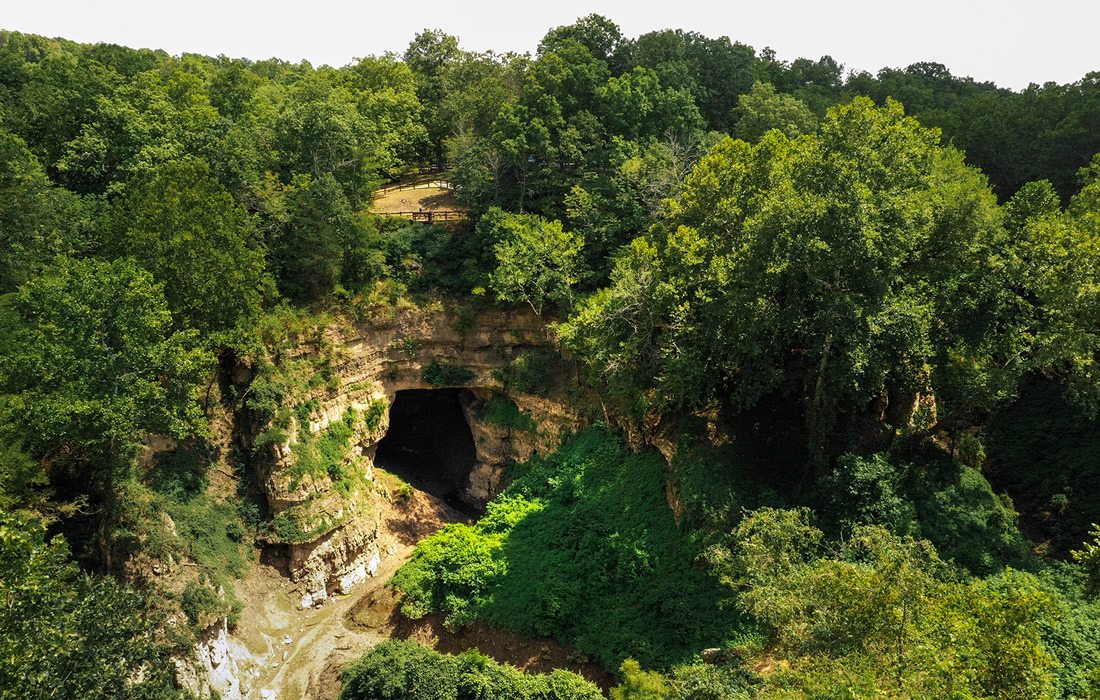
Reach new heights with sweeping vista views over the gulf.
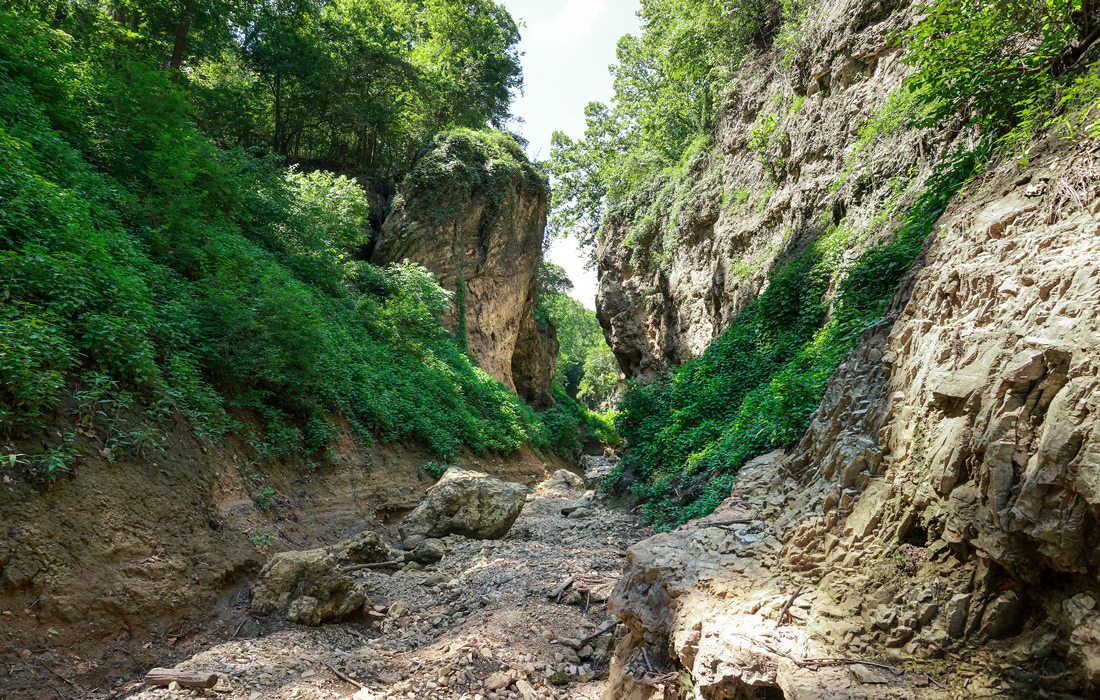
Some people think of Grand Gulf as the Grand Canyon of Missouri.
Grand Gulf State Park
State Highway W, Koshkonong | 2.5 hours southeast of Springfield
If you haven’t visited Grand Gulf State Park yet, put it on your list. The park was developed around one of our state’s natural wonders. Some call it the “Grand Canyon” of Missouri and it’s aptly nicknamed. Grand Gulf is a dolomite and sandstone cave system with 130-foot walls that collapsed roughly 10,000 years ago. Spanning three-quarters of a mile, the canyon is a sight that can’t be fully appreciated in photographs. That includes the 250-foot-wide natural bridge with a 75-foot-high opening.
Early spring is a good time to visit the park before trees fully leaf out because you’ll have better views of the canyon from above. It’s a small park so if you go for the day, combine it with another nearby outdoor adventure at Mammoth Springs—an Arkansas state park less than 15 minutes away. In fact, these two parks on each side of the state line are tied to each other, geologically speaking. The Bussell Branch Creek drains into Grand Gulf, then travels underground about nine miles to re-emerge at Mammoth, contributing to the spring’s flow of 9 million gallons of water per hour.
You don’t need boots at Mammoth Spring but you will at Grand Gulf: This park is mostly for hiking. There are two main trails around the top. The red-blazed Interpretive Trail is a quarter-mile loop with signage and four great overlooks. One large viewing deck looks over a broad, deep section of the gulf that includes a view of the last intact cave.
At the southern end of the trail, a spur descends wooden steps for a deeper view of the collapsed cave. It was open when we went to the park, but it may be closed at times. This area also may have a wet-weather waterfall.
The other loop hike, nearly a mile, is the Natural Bridge Trail, so named because it crosses over the natural bridge. The loop goes along the rim of Grand Gulf, then circles back through the woods to the trailhead. It’s considered a moderate trail and can get close to the edge at times.
You may be wondering: Can I get to the bottom? You can and we did but it’s a bushwhack down and back up. Look for an area that seems safe and doable, but park signage and website messaging urges caution if you do. Also, if there’s been wet weather, the gulf can fill with water in places and may be slippery. Use your best judgment and follow warnings if they are posted. Or just stick to the top trails where you’ll see enough to know why this park is a geologic wonder.—Sony Hocklander
Where to Stay When You Visit Grand Gulf State Park
There are no accommodations in this small state park but the town of Mammoth Spring, Arkansas, has lodging and is less than 15 minutes away: the Saddler Falls Resort with cabins and campsites on the Spring River and Biggers Inn.
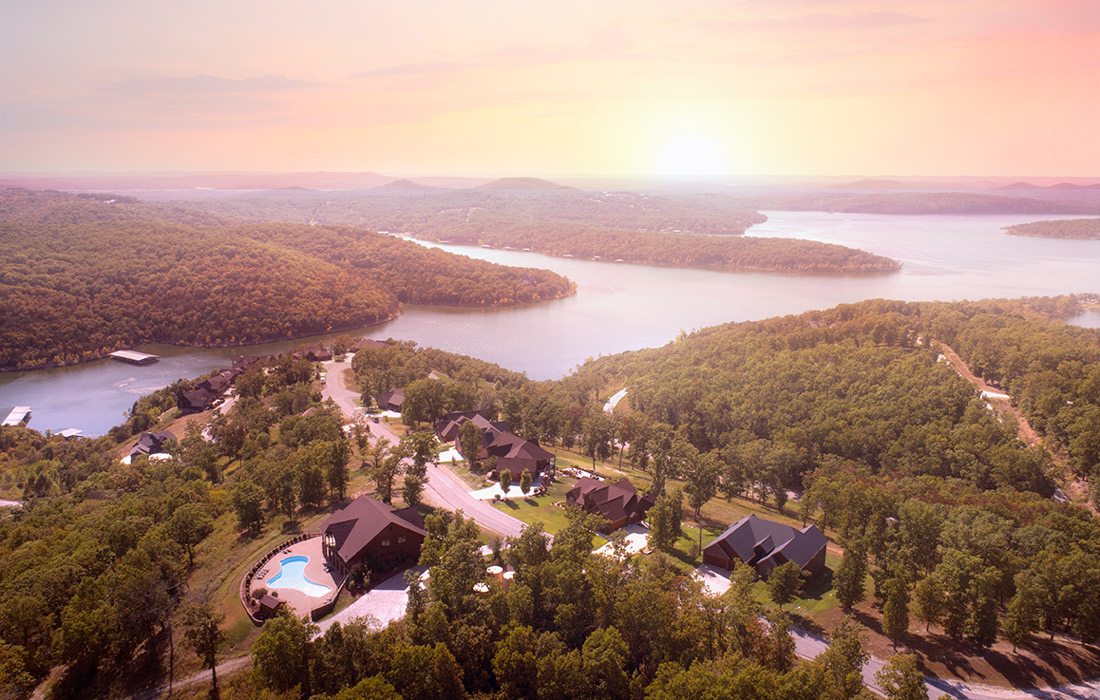
Table Rock State Park
5272 Historic Hwy 165, Branson | 1 hour south of Springfield
With so many arms, coves and bends with 800 miles of shoreline, Table Rock Lake covers a massive area near Branson. Table Rock State Park is a fraction of that, but it makes the perfect basecamp for a lake and Branson vacation, and it’s a fun place to visit for a daytrip adventure.
Looking for watersports? Start at State Park Marina. Not only can you rent a boat, they can outfit your clan with adventure gear too. We have rented pontoons for a day out with visiting family, and kids love to get out on a tube. The marina also offers classic boat tours, guided by a USCG-licensed captain, and a chartered catamaran for large family or friend groups.
When it’s open May to September, we’ve enjoyed grabbing pizza at Café Bridges, the marina’s casual dining spot. (Sometimes packing a picnic is overrated!) Besides pizza, they serve coffee, bakery goods, wings, sandwiches, salads and more. It’s festive to watch boats come and go from the marina while dining.
While we’ve only visited the park for day trips, it has two shoreline campgrounds. The largest, Campground 2, is near the marina and also features a yurt for rent (a more glamping experience). Staying overnight is the best way to take advantage of all there is to do in the area, whether taking in a show or museum, spending a day at Silver Dollar City or playing on the water. And while there isn’t a formal beach in the park, there are places to swim, too.
You don’t need a boat to enjoy lake views. We enjoy strolling the flat, paved Lakeshore Trail, which goes from the marina to the Dewey Short Visitor Center by Table Rock Dam—also worth a stop. The 1.2-mile Chinquapin Trail is another easy path.
If you want to get a good hike in, pick a trail in the White River Valley Trail System that’s also for mountain bikes—a good way for kids to burn energy so they’ll sleep all night in your tent. The trail system shares land between Table Rock State Park and the U.S. Army Corps of Engineers. All told, these loop trails cover more than 11 miles. The red trail is the most challenging and the green loop has the best views. The blue loop is best for nature-lovers. You can only reach the short orange loop via white trail connectors. While these trails are part of the Table Rock State Park system, plenty of others are within a short drive including the Lakeside Forest Trail system, one of my favorite Branson/lake areas to hike and explore. There are trails also across the dam near the Shepherd of the Hills Hatchery—another fun place to visit with kids. Whether you have a few hours or a few days, Table Rock State Park just feels like summer—even in the spring.—Sony Hocklander
Where to Stay When You Visit Table Rock State Park
While there are multiple rentals, hotels, and cabin or condo resorts around the Table Rock Lake and Branson, why not camp inside the state park? There are two campgrounds.
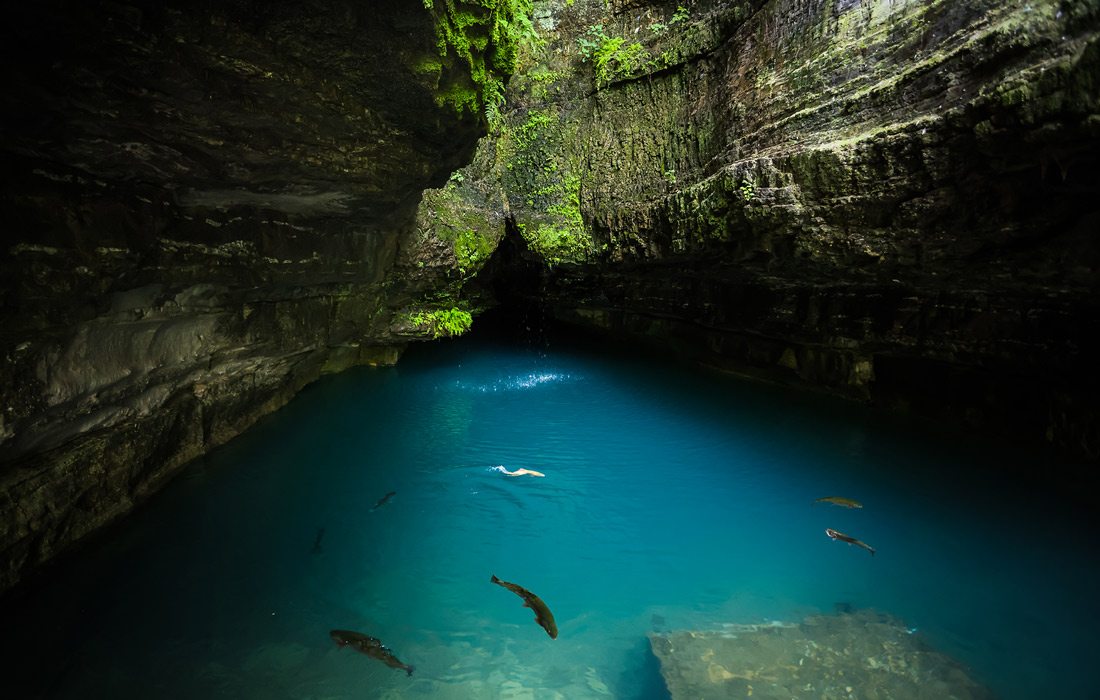
Roaring River State Park
12716 Farm Road 2239, Cassville | 1.25 hours southwest of Springfield
My family and I have a habit of basing our opinions of the park based on the swag in the park store, and let me tell you, Roaring River State Park is killing it. From high-caliber swag and stickers to an ice cream machine, you can find it all.
My family and I are campers, but we checked out the lodge which has a smaller version of the camp store, a restaurant and hotel-style lodging. Fun fact, they deliver pizza down to the campground! If you are interested in restaurant amenities but aren’t interested in going to the lodge, just place a delivery order straight to your camper or cabin door.
Roaring River State Park is very walkable, from the lodge to the store, park to the campground, you wouldn’t have to get in your car if you didn’t want to. It can be a bit of a hike, so it does save time to drive between each stop. The rainbow trout hatchery is a highlight, and don’t miss the cave spring or the short hike above and over the hatchery. Natural terrain and a make-your-toes-tingle lookout over the hatchery from Deer Leap Trail make it fun for the whole family. Even if you aren’t into fly fishing, which no one in my group was, there is a small stretch of river nestled between the two campgrounds where you can put your chairs in the water and enjoy a hot summer day sipping a cool one and watching the kiddos catch tadpoles and crawdads.
The park’s seven trails take you past a variety of terrain, scenery and even interesting structures. Get a little of all of that on the Fire Tower Trail, a rugged 4.4-mile loop with a 1930s Civilian Conservation Corps lookout, dolomite glades, dense woods, and towering bluffs. For an easier stroll, the 0.6-mile River Trails runs right beside Roaring River and is known as a great place to spy wildflowers in the spring.
Another must-do part of a trip to Roaring River State Park actually lies just outside of the park, within a mile of the entrance: BeeBe’s Waterslide (23626 State Highway 112, Cassville). If you ever about killed yourself changing lanes at Hydro Slide on south Campbell in the ’80s and ’90s, nostalgia will hit you like a ton of bricks when you roll up to this blue concrete slide twisting and turning down the hillside. There’s a snack stand with shaved iced and nachos, but make sure you bring cash, as it’s a cash-only establishment. This spot is worth the day trip, even if you aren’t staying at the park.—Megan Johnson, with additional reporting by Katie Pollock Estes
Where to Stay When You Visit Roaring River State Park
You can camp on basic sites, or sites with electric, water and sewer hookups. Or choose to stay in one of the park’s cabins or at the on-site lodge, the Emory Melton Inn.
The Big Three
Get the most bang for your buck with a road trip to Arcadia Valley, where you can visit three of my favorite state parks in one nature-loving weekend.—Katie Pollock Estes

Elephant Rock has massive boulders you won’t find on any other trail.
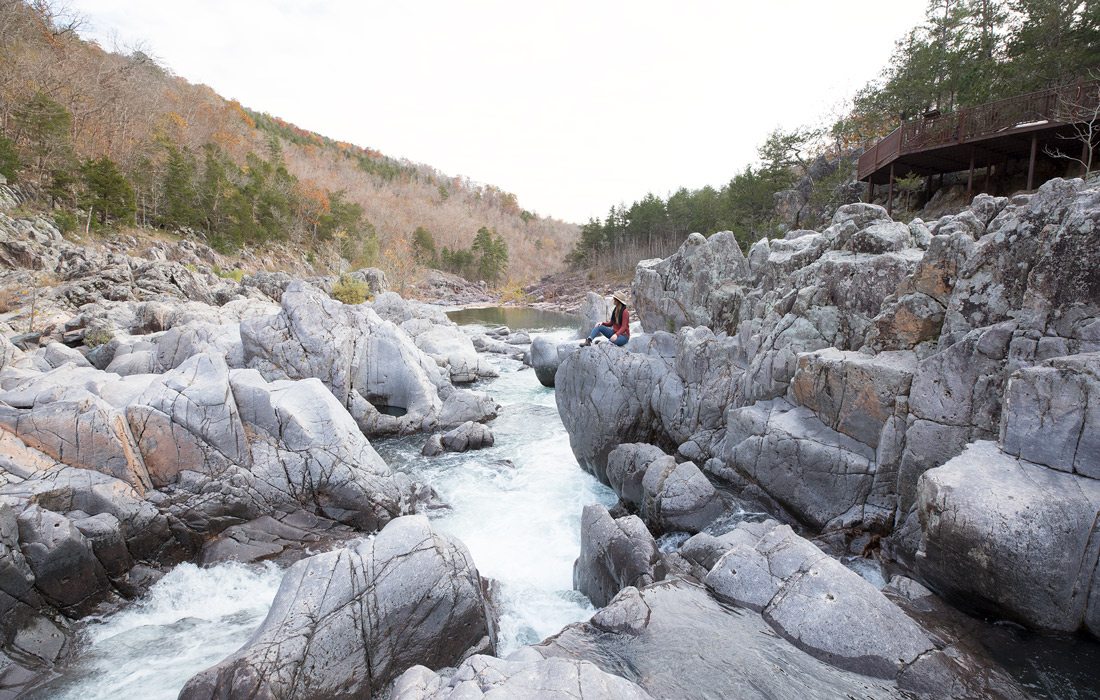
The Johnson Shut-Ins Trail leads straight to the water’s edge.

The beautiful trails at Taum Sauk lead to the best payoff, a waterfall.
Elephant Rock State Park
7406 Highway 21, Belleview | 3.5 hours east of Springfield
Elephant Rocks State Park might not be the biggest park on our list, but I think it’s the perfect size. The Braille Trail (which features braille informational signs along the way) is an easy walk around the park’s massive granite boulders. But you can veer off the path and right up onto the rocks in many places, putting you in an otherworldly environment of giant pink rocks and beautiful views. I like to climb to the large, flat expanse of granite at the top of the rocks and spend some time lounging around in the sun. Hot tip: Throw some picnic goodies in your backpack and have lunch while you’re up there. Or, eat lunch at the park’s food truck that has treats like nachos and shaved ice. Side note: One spur jutting off the Braille Trail leads away from the rocks and into the ruins of an old engine house, a relic from the park’s quarrying and railroad history.
Johnson Shut-Ins State Park
148 Taum Sauk Trail, Middle Brook | 3.5 hours east of Springfield
My favorite thing to do after working up a sweat climbing around at Elephant Rocks: cooling down with a dip in Johnson Shut-Ins. These igneous rock formations in the Black River form chutes and waterfalls that make for some exciting wading and swimming—it’s basically a natural water park. They’re accessed via the Shut-Ins Trail that leads straight to the water’s edge. And although this is one of my all-time favorite places to splash in the water, it can get a little dicey when the water levels are high. Be sure to keep a close eye on any kiddos you bring along. (The only stitches I’ve ever gotten were courtesy of a tumble I took on these rocks—and I was an adult at the time!) The shut-ins might be the park’s main attraction, but they’re not the only one. Hiking and horse trails weave through the park too, and there are cozy cabins if you want to spend the night.
Taum Sauk Mountain State Park
Highway CC, Ironton | 3.75 hours east of Springfield
Like Johnson Shut-Ins, Taum Sauk Mountain State Park is nestled in the St. Francois Mountains. Its defining feature? It’s home to the highest point in the state of Missouri at 1,772 feet above sea level. When I was a kid in the ‘90s, we used to trudge to the very top of a lookout tower, placing us high above everything else to gaze out over a sprawling vista. Was it a little rickety? Yes. Would I be too scared to do it now? Also yes. Today, visitors can instead step out onto a much more comfy lookout deck to admire the view. If you want to hike, you’ll find lovely and wild trails here that cut through rocky glades and deep woods. The Mina Sauk Falls trail takes you to the state’s tallest waterfall, the 132-foot Mina Sauk Falls. Or, you can hop on the Ozark Trail and hike back to Johnson Shut-Ins.
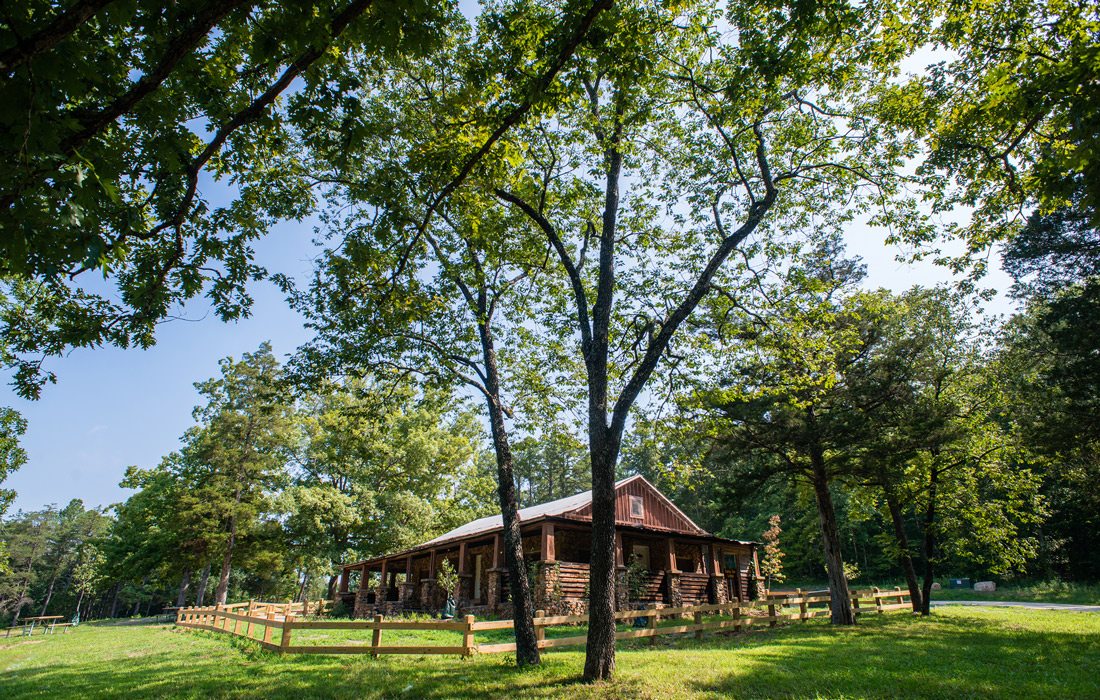
Cabins at Echo Bluff are spacious and centrally located.
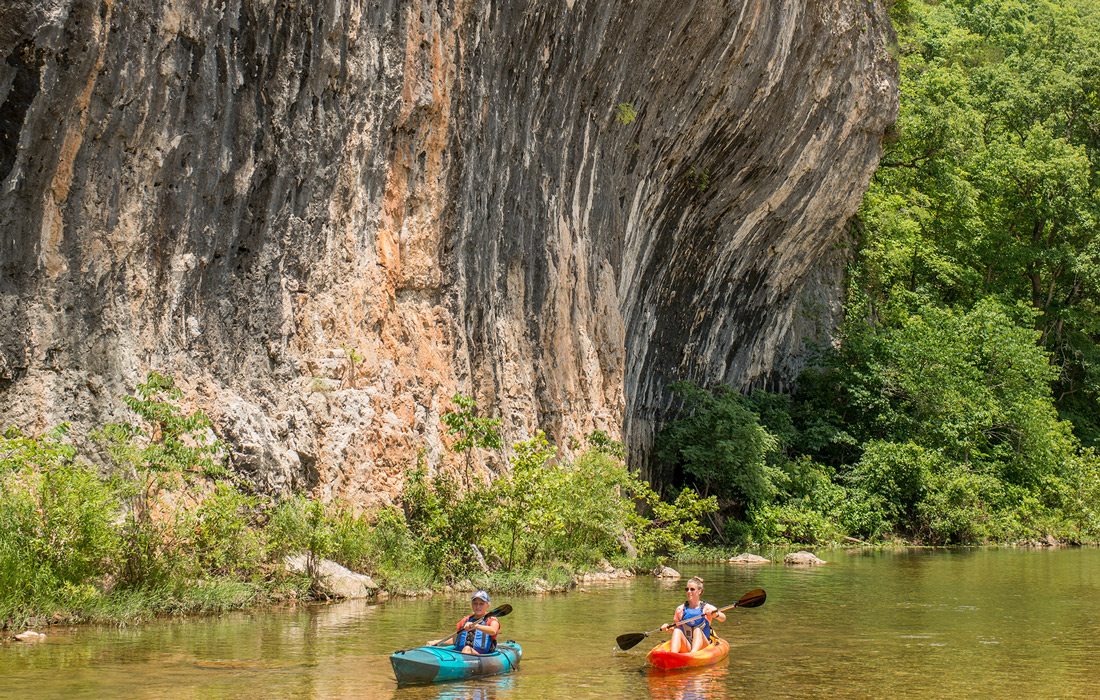
Echo Bluff is the perfect place to float for novices and experts alike.
Echo Bluff State Park
34489 Echo Bluff Dr., Eminence | 2.5 hours east of Springfield
Our family has camped at Echo Bluff State Park every summer since it opened in 2016. And we never miss a chance to take a float trip on the Current River while we’re there. Carr’s Canoe Rental will actually pick you up at your campsite or cabin or in front of the lodge and take you to your put-in point on the river. We like to float from Pulltite to Round Spring. Hot tip: Rent whitewater rafts to make this an easy trip even for a novice floater. Once you begin, Pulltite Spring won’t be far around the bend nestled in on the right before the first large cliff. Park your vessel and hike the small natural trail along the spring to see a historical cabin and make your way to the mouth of the spring.
If you aren’t interested in a major float, or if you have smaller kiddos, you can walk out the far back end of the campground and put your own tubes or floatation devices into the water. Sinking Creek is the body of water that flows through the park, and you can float it all the way to the far side of the park past the lodge and playground. End there, or drop a car at the spot where Sinking Creek and the Current River meet, for an extended, self-guided float.
After your float, hit the camp store for some cold beer and tasty snacks like the ever-popular Dot’s Pretzels. There’s also a restaurant at the lodge where you can sit down to dine—they’ll even deliver a pizza straight to wherever you are staying if you’re using park lodging. They have great RV and tent campsites, cozy cabins and motel-style lodge rooms. State park lodges tend to be no-frills destinations, and that’s certainly true of the lodge room here. But they have everything you need, and they are clean. You’ll be spending most of your time outside anyway, right? Some of the lodge rooms overlook Sinking Creek and the namesake scenic bluff that rises up over it, so you can enjoy a view of the park’s main natural attraction even during any rainy parts of your trip when you can’t go outside.
If you have kiddos with you, don’t miss the playground. It’s a great spot for kids who love to climb and will keep them entertained in between activities like float trips, hiking the park’s 4.23 miles of trails or fishing in the clear water.
One of the best things about this park, though, is its proximity to other cool nearby places that make great day trips if Echo Bluff is your home base. You can head to a walking trail that takes you to an overlook above Round Spring (keep an eye out in that area for beautiful wild horses!), or you can pop over to Current River State Park to spend an afternoon exploring there. Nearby Rocky Falls Shut-Ins is an excellent stop for a scenic swim, and The Dairy Shack in Eminence is 50% burgers and shakes and 50% sweet nostalgia.—Megan Johnson, with additional reporting by Katie Pollock Estes.
Where to Stay When You Visit Echo Bluff State Park
Cabins are the way to go here. They are spacious and centrally located, so you can quickly walk over to the lodge for a meal or to Sinking Creek to wade. Plus, each one has a fireplace for cozy nights.
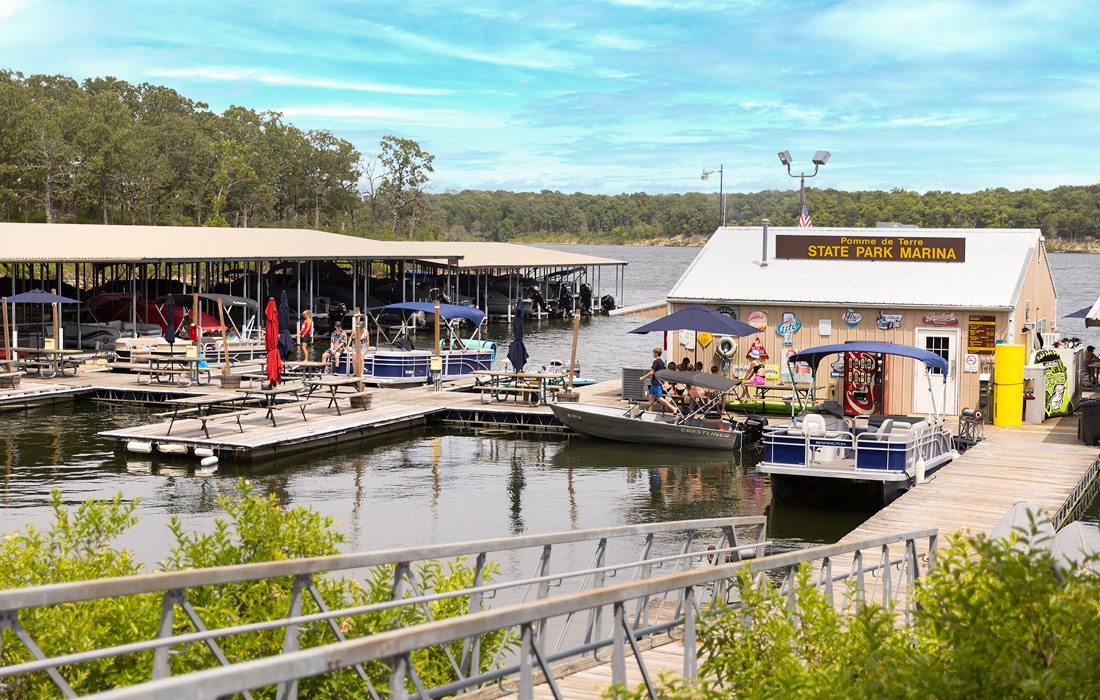
Pomme de Terre State Park
23451 Park Entrance Road, Pittsburg | 1 hour north of Springfield
Everyone thinks of Table Rock when we hear someone say, “I’m headed to the lake!” But this pretty little lake to the north is a peaceful destination that deserves some love too. Our family camps at Pomme de Terre Lake each holiday weekend, and the highlight is a boat ride to the Marina at Pomme. The new owners expanded it from a small ice cream shop on the water (which we still partake of each trip) to also selling hot foods and premier cocktails at the tiki bar (which we now partake of every trip too). And of course, if you aren’t boating in on your own vessel, you can rent one from the marina, where they offer pontoons, canoes, kayaks and more for day rentals on the lake.
Pomme de Terre State Park sits on both sides of Pomme de Terre Lake and is a great fishing spot if you’re interested in bass, catfish, muskie, crappie and walleye. And if you want to enjoy a dip in the water but don’t have a boat, you can find your way to the two quiet swimming beaches. There are only two trails at Pomme de Terre State Park, but they are both lovely options for a day spent outside. For a nice hike that’s not too tough, try the Cedar Bluff Trail loop. At 1.6 miles and moderate difficulty, it takes you along rocky bluffs that butt out over the lake. It weaves in and out of the forest, so you get those shady wooded moments and those gorgeous lake-view moments. The Indian Point Trail loop is also moderate but is a bit longer at 2.7 miles that meander through oak and hickory woods, with plenty of wildlife to see or hear if you’re quiet. It’s also a great trail for spying wildflowers in the spring.
Pomme de Terre State Park has upped their lodging game in recent years, offering a few options that let you rough it just a little bit while also staying pretty darn comfy. First up are the sweet little yurts with wrap-around decks and picnic areas. The newly built camper cabins don’t have running water, but they do have electricity, climate control and comfy bedrooms—plus their own fire pits. There are campsites, a marina cabin and a lake house too, if those are more your speed.—Megan Johnson, with additional reporting by Katie Pollock Estes.
Where to Stay When You Visit Pomme de Terre State Park
Our favorite Pomme de Terre State Park options are the super-cute yurts. They are the most darling way to get that camping vibe without actually roughing it too much.
5 Must-Visit Parks in Northwest Arkansas
Crater of Diamonds
209 State Park Road, Murfreesboro
At this one-of-a-kind state park, you can spend your day digging for diamonds and other precious gems. It’s all about the thrill of the chase—you might come away with a little speck of a gem, or you might find a multi-carat diamond. You get to keep anything you find in the 37-acre eroded volcanic crater. Although there aren’t cabins on site, you can reserve a campsite. There’s a splash pool there too, where you can cool off after a sweaty day of digging.
Devil’s Den
11333 W. Arkansas Highway 74, West Fork
The Civilian Conservation Corps wood-and-stone structures (like the gorgeous scenic overlook) add personality to this park, which is home to great trails. They range from ¼ mile to 15 miles and take you to spots like the rock dam over Lee Creek, wet weather waterfalls, natural bridges, Lake Devil and the Vista Point rock overlook that juts out over Blackburn Valley. You can also go mountain biking on Fossil Flats trail. The park has cabins, campsites, a restaurant and a pool where you can splash around post-hike.
Mount Magazine
16878 Arkansas 309, Paris
This park is home to the highest point in the state, and it’s home to some popular hang gliding launch points. But even if you don’t want to leap off a mountaintop, there are outdoor adventures for every interest and skill level: hiking, mountain biking, horseback riding, rock climbing and more. To get to the highest peak in the state, just take the 1.5-mile, moderately difficult Signal Hill Trail. As for where you’ll rest your head, there is a hotel-style lodge, several cabins and some campsites—plus Skycrest Restaurant and a heated indoor swimming pool.
Petit Jean
1285 Petit Jean Mountain Road, Morrilton
Only 3.5 hours south of Springfield, Petit Jean State Park makes a perfect weekend adventure destination for outdoor enthusiasts. Arkansas’ first state park offers swimming, fishing, paddling, hiking and cycling, and its sunrise and sunset overlooks are legendary. A springtime visit is best to catch beautiful creek cascades and the 95-foot Cedar Falls, although the park’s fall color is hard to beat. With two pools and lake recreation, Petit Jean attracts families during summer too.
History and Heart
Mather Lodge is the heart of Petit Jean. It’s the only Arkansas state park lodge built primarily by the Civilian Conservation Corps (CCC). The lobby, rooms and breezeway were constructed in the 1930s; renovated areas include the front desk, gift shop, dining hall and bar. Large windows, mountain decor and historic touches enhance the building’s charm. Outside, generous seating paired with a knockout view of Cedar Creek Canyon makes the breezeway and patio a great spot to linger. Signs of park history are everywhere. Just off the main road, a green space honors park builders with a statue and remnants of the CCC camp. If you like to explore, wander by the arched Davies Bridge built in 1934 over Cedar Creek near a waterfall.
Outdoor Recreation
In many ways, this park is like an outdoor resort. There’s so much to do! A summer season boathouse on the 100-acre Bailey Lake features a snack bar and boat rentals. A fishing dock near the boathouse makes a nice spot to drop a line or enjoy lake views. Ready for a spring paddle? Kayaks are available to rent year-round from a self-serve kiosk. The park also features picnic areas and shelters, two playgrounds, tennis and basketball courts and two swimming pools (one public, one for lodge and cabin guests only). Don’t miss the multi-use visitor center near the lake. You’ll find an oversized outdoor stone fireplace, a gift shop, park information and interactive exhibits about park history and geology.
Nature Trails
Ancient geology is the hallmark of Petit Jean. Discover awe-inspiring rock formations, scenic creek views and waterfalls from 20 miles of trails. Some are short to reach points of interest. Longer hikes go through forests and meadows, to sheer bluff overlooks and along Cedar Creek. The popular trail to Cedar Falls descends nearly 370 feet from Mather Lodge to the base of Cedar Creek Canyon. The 2-mile out-and-back trail is moderately challenging, but the effort is worth it to see the grotto waterfall. An easy boardwalk trail leads to views of the waterfall from above. The scenic 1.2-mile Cedar Creek loop begins at a historic cabin. The trail climbs high into the bluffs, drops to creek levels and passes through an angular natural bridge. The 4.5-mile Seven Hollows loop trail is the most diverse with a huge natural bridge, a side-spur grotto and waterfall, turtle rocks, creek areas and much more. In addition, two quarter-mile trails lead to Bear Cave and the Rock House Cave.
Overlooks
Don’t miss the park’s best vistas. In addition to western views from Mather Lodge, a shelter overlooking Petit Jean River is the best place to catch a sunset. For sunrise—or anytime—head east out of the main park to Stout’s Point for breathtaking mountain views above the Arkansas River Valley. Near a small fenced gravesite tucked among boulders, you’ll also learn the tragic romantic legend of Petit Jean. According to legend, Petit Jean was engaged to a French nobleman who, in the 1700s, planned to sail to the New World. She refused to be left behind. Disguising herself as a cabin boy known as Petit Jean (“Little John”), she even fooled her fiance. After sailing up the Arkansas River, Petit Jean became fatally ill, revealed herself and asked to be buried on the mountain. Her tale, like the mountain that bears her name, is another enchanting reason to visit Petit Jean.
Lake Catherine
1200 Catherine Park Road, Hot Springs
Nestled in the Ouachita Mountains beside Lake Catherine, this park offers beautiful scenery. Hike Falls Branch Trail to see the Falls Creek Falls that spill into a scenic pool below, take a guided horseback riding trip or just rent a boat from the marina and play on the lake. If you’re spending the night and don’t want to camp, they have multiple types of cabins and a yurt too.









